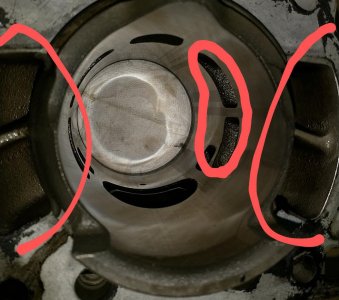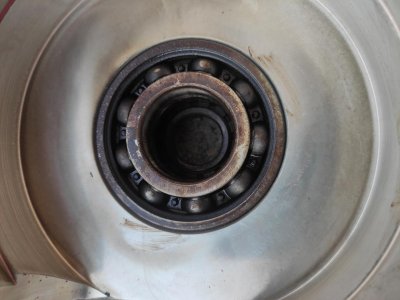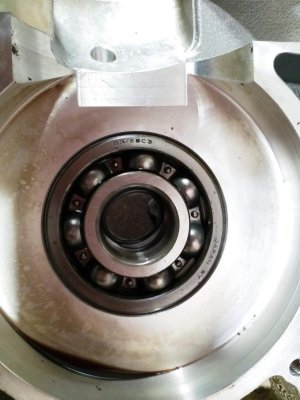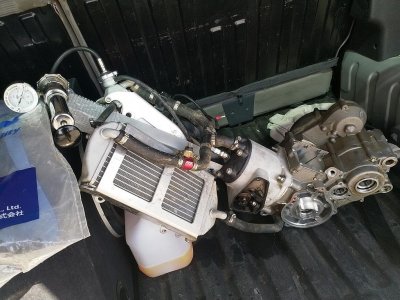Hola a todos,me presento desde Spain con una GASGAS EC 300 GP 2018. Investigando por la web el problema que tengo(y muchos teneis por lo que he leido) encontre este foro con la esperanza de que alguien sepa cual puede ser el problema. Compre la moto hace 7 meses, venia con los rodamientos del cigue?al estropeados y se los puse nuevos(63/28 FAG y 6206 en C3 FAG en lugar de c4). Al abrir el motor me encontre cigue?al y rodamientos todo de un color marron-negro ,que pienso que es oxido. Pense en que el anterior propietario caeria en un rio o algo y le entro agua al motor. Y ahora, 2000km despues otra vez el mismo problema. Se los he vuelto a cambiar,esta vez 63/28 NSK y 6206 C3 SKF, ademas de cambiar la biela que ya presentaba cierto desgaste. 200km le e echo al motor desde entonces,y otra vez tienen holgura los rodamientos haciendo la prueba con el volante magnetico, como es posible??alguien sabe por que puede ser?perdonar si no se entiende algo al usar el traductor,espero que podamos entendernos bien.
You are using an out of date browser. It may not display this or other websites correctly.
You should upgrade or use an alternative browser.
You should upgrade or use an alternative browser.
Bottom end failure - 2018 EC300
- Thread starter Booki
- Start date
My case exactly, bought at 62 hrs, replaced top end, at 65 bottom fail, found rusty and failed bearings and crank inside. Crankcase chamber and transfer ports had darkish discoloration which looked like burned antifreeze deposits. Cleaned off with some chemicals. Piston was black underneath, indicating heat, even though sparkplug was richish.
Could be crankcase porosity, warped head, wrong head oring, previous owner neglection (drowning, pressure cleaning), failing plastic cage bearing, cylinder base gasket leak.
Many options.
Kind of not in a hurry to assemble the engine, since Im not sure if it could be a repeatory behaviour untill true culpit is found.
Even worse case was documented on YT, but dont know if he resolved the exact cause.
Do you have a link for the youtube case? (assuming thats what you mean by YT)
It is interesting about the cause - i am not really sure what the cause could be...
Mine is all back together now and running great. Put the stock pilot jet back in and just hoping for the best. All bearings replaced, if it fails in another 2000km, I won't be keeping the bike thats for sure.
Hola a todos,me presento desde Spain con una GASGAS EC 300 GP 2018. Investigando por la web el problema que tengo(y muchos teneis por lo que he leido) encontre este foro con la esperanza de que alguien sepa cual puede ser el problema. Compre la moto hace 7 meses, venia con los rodamientos del cigue?al estropeados y se los puse nuevos(63/28 FAG y 6206 en C3 FAG en lugar de c4). Al abrir el motor me encontre cigue?al y rodamientos todo de un color marron-negro ,que pienso que es oxido. Pense en que el anterior propietario caeria en un rio o algo y le entro agua al motor. Y ahora, 2000km despues otra vez el mismo problema. Se los he vuelto a cambiar,esta vez 63/28 NSK y 6206 C3 SKF, ademas de cambiar la biela que ya presentaba cierto desgaste. 200km le e echo al motor desde entonces,y otra vez tienen holgura los rodamientos haciendo la prueba con el volante magnetico, como es posible??alguien sabe por que puede ser?perdonar si no se entiende algo al usar el traductor,espero que podamos entendernos bien.
Are you saying you had failure at 2000km as well? Same time for me when mine failed. Crank also looked rusty too. Not sure what is causing failure, I have just put my bike back together and it is running well - hope it will stay running. But I do not know the cause.
Do you have a link for the youtube case? (assuming thats what you mean by YT)
It is interesting about the cause - i am not really sure what the cause could be...
Mine is all back together now and running great. Put the stock pilot jet back in and just hoping for the best. All bearings replaced, if it fails in another 2000km, I won't be keeping the bike thats for sure.
https://youtu.be/f46vQ9XtSxY
Ive had crank rebalanced. It was 0.05 left, 0.04 right side. 0.05 mm is max allowed by '06 manual. A tad bigger misalignment could inflict bearing damage over time, but not necessary.. Corrected to 0.02mm.
Slowly coming together.
Had a chat with yt channel cross enduro training, where he specialized in research of failing beta main bearings, but nothing exact was ever determined. Just possible bad bearing batch, bad seals, bad bearing installation from factory etc...but no explanation for rusty crank of non washed or flooded bike.
Are you saying you had failure at 2000km as well? Same time for me when mine failed. Crank also looked rusty too. Not sure what is causing failure, I have just put my bike back together and it is running well - hope it will stay running. But I do not know the cause.
Exacto,en 2000km rodamientos k.o.,bueno en realidad solo el del lado del encendido,el otro no,y todo oxidado. Es como si dentro del motor hubiera condensacion de agua,es raro. Anterior a esta tuve una ec250 2003,que es el mismo motor a diferencia de la forma del carter izquierdo para incluir el arranque electrico,el crank y poco mas. Jamas me dio problemas de rodamientos del crank en 8 year y muchos km.
Y queria decir tambien que Despues de 200km otra vez tienen holgura los rodamientos haciendo la prueba con el volante magnetico, como es posible??alguien sabe por que puede ser?perdonar si no se entiende algo al usar el traductor,espero que podamos entendernos bien.Hola a todos,me presento desde Spain con una GASGAS EC 300 GP 2018. Investigando por la web el problema que tengo(y muchos teneis por lo que he leido) encontre este foro con la esperanza de que alguien sepa cual puede ser el problema. Compre la moto hace 7 meses, venia con los rodamientos del cigue?al estropeados y se los puse nuevos(63/28 FAG y 6206 en C3 FAG en lugar de c4). Al abrir el motor me encontre cigue?al y rodamientos todo de un color marron-negro ,que pienso que es oxido. Pense en que el anterior propietario caeria en un rio o algo y le entro agua al motor. Y ahora, 2000km despues otra vez el mismo problema. Se los he vuelto a cambiar,esta vez 63/28 NSK y 6206 C3 SKF, ademas de cambiar la biela que ya presentaba cierto desgaste. 200km le e echo al motor desde entonces
swazi_matt
Active member
did you have your bike from new? that would help clear up the current thinking that first owner may have drowned the bikeExacto,en 2000km rodamientos k.o.,bueno en realidad solo el del lado del encendido,el otro no,y todo oxidado. Es como si dentro del motor hubiera condensacion de agua,es raro. Anterior a esta tuve una ec250 2003,que es el mismo motor a diferencia de la forma del carter izquierdo para incluir el arranque electrico,el crank y poco mas. Jamas me dio problemas de rodamientos del crank en 8 year y muchos km.
did you have your bike from new? that would help clear up the current thinking that first owner may have drowned the bike
Si,cuando la compre le cambie los rodamientos. En 7 meses le e echo 2000km y han vuelvo a deteriorarse,no se han llegado a romper pero ya estaban haciendo ruido.
Si,cuando la compre le cambie los rodamientos. En 7 meses le e echo 2000km y han vuelvo a deteriorarse,no se han llegado a romper pero ya estaban haciendo ruido.
Did you measure original head inner oring. Mine was 1.9mm, instead of 1.78mm (from new), which caused coolant blowby over time into gearbox and maybe into crank.
Also, did you have your crankshaft measured for alignment. Mine was at the top of allowable free play, at 0.05mm. I've corrected it to 0.02mm.
Were your cylinder trasfer ports discoloured, darker. (check attachment) They should be aluminum light colour. I'm assuming it could be from antifreeze leak.
Next thing I noticed, was original piston rings having half the allowable minimum ring end gap, 0.25mm instead 0.5mm, So it might have added some extra binding heat to equasion. More heat, more expansion for possible leak. It also made vertical lines on cylinder wall.
What torque did you use on the crankcase bolts 0.8 kg or 1kg? There could also be a crank leak of coolant, in small amounts, but enough to corrode the insides over time. While you think that topping up small amout of coolant after few rides is normal, but it is not, if there is no boil over.
Attachments
Did you measure original head inner oring. Mine was 1.9mm, instead of 1.78mm (from new), which caused coolant blowby over time into gearbox and maybe into crank.
Also, did you have your crankshaft measured for alignment. Mine was at the top of allowable free play, at 0.05mm. I've corrected it to 0.02mm.
Were your cylinder trasfer ports discoloured, darker. (check attachment) They should be aluminum light colour. I'm assuming it could be from antifreeze leak.
Next thing I noticed, was original piston rings having half the allowable minimum ring end gap, 0.25mm instead 0.5mm, So it might have added some extra binding heat to equasion. More heat, more expansion for possible leak. It also made vertical lines on cylinder wall.
What torque did you use on the crankcase bolts 0.8 kg or 1kg? There could also be a crank leak of coolant, in small amounts, but enough to corrode the insides over time. While you think that topping up small amout of coolant after few rides is normal, but it is not, if there is no boil over.
Perdona No entiendo, te refieres a la hendidura del cilindro donde van las juntas toricas?
La alineacion del crankshaft no lo he medido,pero ahora cuando he cambiado los rodamientos otra vez he cambiado tambien la biela y lo han equilibrado.
Si no recuerdo mal los puertos de transferencia del cilindro tenian ese color que dices.
Los anillos del piston tienen tolerancia correcta,y el cilindro estaba en perfecto estado.
Los pernos del carter los he apretado sin llave dinamometrica, pero 1kg-1'5kg deben tener. En caso de haber una fuga de anticongelante, la compresion del motor se iria al circuito se refrigeracion y en ese caso deber?a haber mas presion de la normal en el circuito no?
Adjunto fotos de como estaba el carter y rodamientos con 2000km, el crankshaft estaba igual.
Attachments
I was thinking of head oring, it has two, bigger and smaller, both should be 1.78mm thick. If it is thicker, there is a compression blowby into gearbox, mixing coolant and gear oil. It could also push coolant into crank area, if there is a crack or bad seal between the cases. There could be only small coolant leak but in a longer timespan, this damage could happen. It is chronic, not acute occurance.
if bike is not flooded and is pressure cleaned correctly, there is no way, water could enter and corrode the bearings and crankshaft in just one instance.
I've cleaned other bikes numerous times without being extremely cautious, and nothing happened in years time.
This corrosion, on the other hand, has some deeper meaning. Same is happening to beta 300RR and xtrainer from 2015 till today. They even say 5-10% are affected. Its like enduro virus.
Beta's original response was: a bad batch of bearings, then changed to factory wrong bearing installation and again switched to bad bearing theory.
Beta uses NTN stock, so they say NTN is faulty. GG uses SKF explorer. And we are having SKFs fail...
I went for SNR and NTN combo, C3 & C4, but I think bearings are not to blame. Bad bearings fail in just couple of hrs.
Somewhere somehow there is a small leak into crank area, which in year or two kills the innards.
My engine is now apart for the first time, but you are having a 3rd occurence, therefore water entering somehow is the only thing I can think of.
Unless you are purposefully flooding the bike through carb and exhaust, not running it after washing and leaving it for weeks at a time, full of water....there's sth going on.
if bike is not flooded and is pressure cleaned correctly, there is no way, water could enter and corrode the bearings and crankshaft in just one instance.
I've cleaned other bikes numerous times without being extremely cautious, and nothing happened in years time.
This corrosion, on the other hand, has some deeper meaning. Same is happening to beta 300RR and xtrainer from 2015 till today. They even say 5-10% are affected. Its like enduro virus.
Beta's original response was: a bad batch of bearings, then changed to factory wrong bearing installation and again switched to bad bearing theory.
Beta uses NTN stock, so they say NTN is faulty. GG uses SKF explorer. And we are having SKFs fail...
I went for SNR and NTN combo, C3 & C4, but I think bearings are not to blame. Bad bearings fail in just couple of hrs.
Somewhere somehow there is a small leak into crank area, which in year or two kills the innards.
My engine is now apart for the first time, but you are having a 3rd occurence, therefore water entering somehow is the only thing I can think of.
Unless you are purposefully flooding the bike through carb and exhaust, not running it after washing and leaving it for weeks at a time, full of water....there's sth going on.
En mi caso no hay agua en la caja de cambios,pero de todos modos es muy raro que los rodamientos se estropeen en poco tiempo. Por lavar la motocicleta no es,eso seguro. Como la compre usada y ya tenia los rodamientos en mal estado(y todo oxidado),pense que la motocicleta caeria en algun rio con el anterior propietario. Pero parece que el problema es otro. Investigando tambien vi el caso de Beta, que como dices le echaban la culpa a los rodamientos o instalacion de estos,el caso es que los rodamientos aparecian con oxido igual que las GG. Tambien se,como dato curioso, que todas las GG que han dado problemas de rodamientos de crankshaft son 300cc (algunas han agrandado el alojamiento del rodamiento en el carter,que hace que no ajuste)y 2018, las 250cc 2018 no conozco ningun caso.
Yes. Bearing will destroy the case if bearing cage fails due to corrosion or other factors. Balls from bearing then accumulate together untill it locks and starts rotating outer bearing race in its seat.
It could be faulty bearing if it fails after first few running hrs, or due to water or coolant constant leak if it fails in 1000-2000km range.
I would certainly rule out water in fuel or 2t oil, since not all bikes are affected.
Cracked cylinder water channel would not leak into crank during riding, but could leak down while stopped.
Casting inperfections on the cases, where water channels pass the crank area closely could also leak water inside.
Maybe not much during riding, but when cooling and not in use.
Pressure test of the cooling system should reveal a leak, but some sort of marking fluid, just like testing aircon system leak, should be used, to pinpoint location.
We're talking small amount of water at a constant rate. Not enough to disrupt compression, but enough, that slowly in 1-2 years or few months rust the bottom end, even though it is
covered in oil and somewhat protected.
I dont know how antifreeze/water mix reacts with oil covered steel, but it doesnt seem to do good.
Maybe even antifreeze type is to be consider, red, pink being more aggressive than blue.
Maybe AndreaGG from enduropuro.it has some clues, if they did any warranty replacements, like beta did.
Last picture shows old bearing prior to removal from my previous bike, how it should look like.
It could be faulty bearing if it fails after first few running hrs, or due to water or coolant constant leak if it fails in 1000-2000km range.
I would certainly rule out water in fuel or 2t oil, since not all bikes are affected.
Cracked cylinder water channel would not leak into crank during riding, but could leak down while stopped.
Casting inperfections on the cases, where water channels pass the crank area closely could also leak water inside.
Maybe not much during riding, but when cooling and not in use.
Pressure test of the cooling system should reveal a leak, but some sort of marking fluid, just like testing aircon system leak, should be used, to pinpoint location.
We're talking small amount of water at a constant rate. Not enough to disrupt compression, but enough, that slowly in 1-2 years or few months rust the bottom end, even though it is
covered in oil and somewhat protected.
I dont know how antifreeze/water mix reacts with oil covered steel, but it doesnt seem to do good.
Maybe even antifreeze type is to be consider, red, pink being more aggressive than blue.
Maybe AndreaGG from enduropuro.it has some clues, if they did any warranty replacements, like beta did.
Last picture shows old bearing prior to removal from my previous bike, how it should look like.
Attachments
Last edited:
Ojala descubramos el problema, son motocicletas muy buenas y no me gustaria tener que cambiarla. Como ya sabras, el motor de las 250cc y 300cc es identico excepto cilindro,cylinder head y piston,y como dije en la anterior respuesta no conozco ningun caso de 250cc con este problema,todas son 300cc. Lo que me hace pensar que el problema quizas lo tengamos en el cilindro. Desde luego esta claro que si hay oxido es porque de alguna manera entra agua,como entra ya veremos si lo averiguamos. AndreaGG no esta en este foro?
Either 300 cylinder fault or a certain batch of porous cases, that coincidentaly got used on 300's.
Maybe assembling the engine cases with cylinder, without gearbox, crank, piston, and connecting cooling system, pressurizing it and observing.
Andrea is on forum, but is not very active, I've sent him email.
Maybe assembling the engine cases with cylinder, without gearbox, crank, piston, and connecting cooling system, pressurizing it and observing.
Andrea is on forum, but is not very active, I've sent him email.
So far so bad.
First try was using only air, then coolant. When pressurized coolant, pressure drop was slower, but nontheless should be nonexistent. Starting point at 180 Kpa or 1.8 bar, as per cap blow off value. It held even 1.9 pressure.
https://www.youtube.com/watch?v=cZ-ImSU6yyQ
Next job is submerging whole engine, using air only in cooling system and observing bubbles.
First try was using only air, then coolant. When pressurized coolant, pressure drop was slower, but nontheless should be nonexistent. Starting point at 180 Kpa or 1.8 bar, as per cap blow off value. It held even 1.9 pressure.
https://www.youtube.com/watch?v=cZ-ImSU6yyQ
Next job is submerging whole engine, using air only in cooling system and observing bubbles.
Attachments
Interesante prueba,muchas gracias por compartir. Por lo que veo y entiendo,si no se mantiene la presion es porque hay alguna fuga en algun punto.
Yo por mi parte,he dejado la motocicleta parada mas de 1 semana para ver si el nivel de anticongelante bajaba(y no ha sido asi)y ademas he probado a arrancarla ,pararla a los pocos segundos y quitar la bujia para ver si habia restos de agua. En el cilindro-piston(por la tobera de escape) tambien e echado un vistazo y no hay nada de agua,la cabeza del piston negra. De haber quemado anticongelante tendria color claro.
Espero tus avances con las pruebas que estas haciendo, ojala averiguar donde esta el problema.
Edito: al haber usado refrigerante presurizado,no se visualiza donde esta la fuga?
Yo por mi parte,he dejado la motocicleta parada mas de 1 semana para ver si el nivel de anticongelante bajaba(y no ha sido asi)y ademas he probado a arrancarla ,pararla a los pocos segundos y quitar la bujia para ver si habia restos de agua. En el cilindro-piston(por la tobera de escape) tambien e echado un vistazo y no hay nada de agua,la cabeza del piston negra. De haber quemado anticongelante tendria color claro.
Espero tus avances con las pruebas que estas haciendo, ojala averiguar donde esta el problema.
Edito: al haber usado refrigerante presurizado,no se visualiza donde esta la fuga?
Similar threads
- Replies
- 7
- Views
- 907
- Replies
- 12
- Views
- 1K
- Replies
- 1
- Views
- 2K
- Replies
- 2
- Views
- 954








